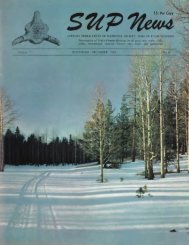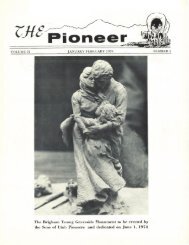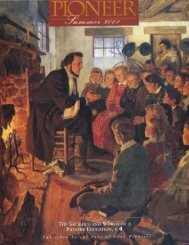Pioneer: 2011 Vol.58 No.3
You also want an ePaper? Increase the reach of your titles
YUMPU automatically turns print PDFs into web optimized ePapers that Google loves.
from Church History Museum<br />
City plat above<br />
courtesy Harold B.<br />
Lee Library, Brigham<br />
Young University.<br />
The sense of order<br />
and uniformity, which<br />
is still evident in<br />
1870, was a result<br />
of the extensive and<br />
detailed city planning<br />
guidelines that the<br />
Saints sustained and<br />
accepted for their<br />
community.<br />
In harmony with the principles and ideals of<br />
Joseph Smith’s vision of the “City of Zion,” the<br />
city was platted in a square grid oriented to<br />
the cardinal compass directions with the Temple<br />
Block at its very heart. It was to be a city of uniform<br />
garden lots, with all farming taking place in<br />
the “Big Field” south of present-day Ninth South.<br />
The first plat (Plat A) of the city was laid out in<br />
August 1847 by Orson Pratt and Henry Sherwood.<br />
The initial survey included 135 blocks often acres<br />
each subdivided into eight lots of 1.114 acres. The<br />
lots were numbered one to eight beginning with<br />
the lot on the southeast corner. The streets were<br />
132 feet wide from curb to curb. In addition to<br />
Temple Square, three other blocks were designated<br />
as public land, including the block upon which<br />
the fort was built. South Temple and East Temple<br />
(Main Street) were the east–west and north–south<br />
streets from which other streets were oriented.<br />
Thus, the first east–west street south of South<br />
Temple was First South and the next was Second<br />
South. The same pattern was repeated to the east.<br />
A problem was created by West Temple and North<br />
Temple. They were not considered First West or<br />
First North respectively, as they would have been<br />
if the pattern of numbering streets from the corner<br />
of East and South Temple had been strictly applied.<br />
Instead, these streets held their own designations,<br />
of North Temple and West Temple. First<br />
North and First West were assigned to the first<br />
streets farther north and west, respectively. When<br />
residences or business locations were assigned<br />
street numbers in December 1883, the numbers<br />
were oriented from the geodetic survey marker<br />
placed at the southeast corner of Temple Square by<br />
Orson Pratt.<br />
For more than one hundred years, this system<br />
caused confusion on the north and west portions of<br />
the Salt Lake City grid system of streets. The problem<br />
was solved in 1971/72 when West Temple was<br />
also designated First West and North Temple as First<br />
Left artwork located at Sons of Utah <strong>Pioneer</strong>s headquarters.<br />
<strong>Pioneer</strong> <strong>2011</strong> ■<br />
volume 58 ■<br />
number 3 7<br />
www<br />
■<br />
sonsofutahpioneers<br />
■<br />
org







